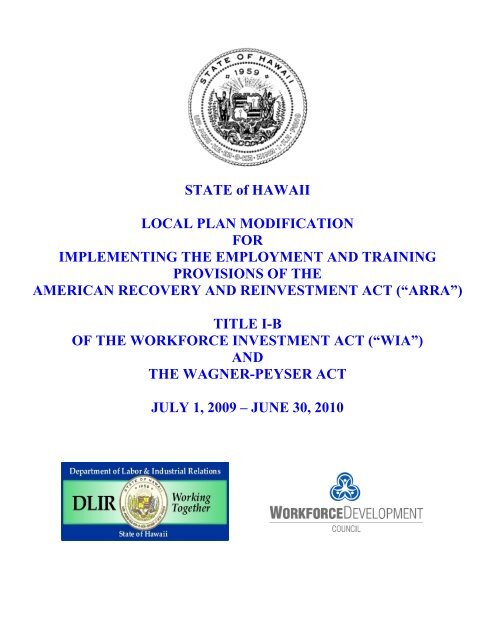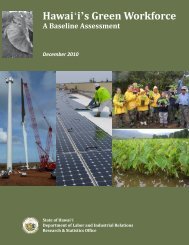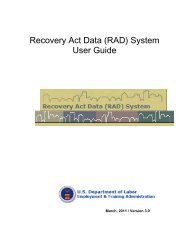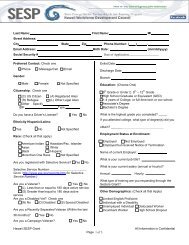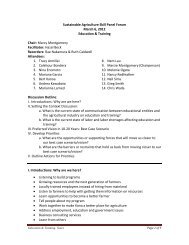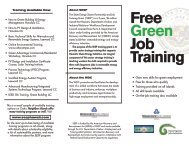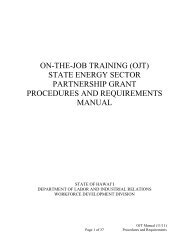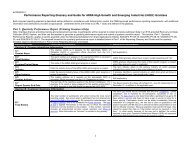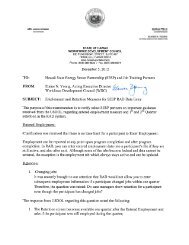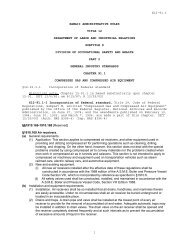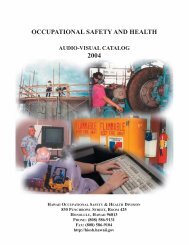Exhibit E2 - Department of Labor and Industrial Relations - Hawaii.gov
Exhibit E2 - Department of Labor and Industrial Relations - Hawaii.gov
Exhibit E2 - Department of Labor and Industrial Relations - Hawaii.gov
You also want an ePaper? Increase the reach of your titles
YUMPU automatically turns print PDFs into web optimized ePapers that Google loves.
STATE <strong>of</strong> HAWAII<br />
LOCAL PLAN MODIFICATION<br />
FOR<br />
IMPLEMENTING THE EMPLOYMENT AND TRAINING<br />
PROVISIONS OF THE<br />
AMERICAN RECOVERY AND REINVESTMENT ACT (“ARRA”)<br />
TITLE I-B<br />
OF THE WORKFORCE INVESTMENT ACT (“WIA”)<br />
AND<br />
THE WAGNER-PEYSER ACT<br />
JULY 1, 2009 – JUNE 30, 2010
HAWAII INSTRUCTIONS<br />
For July 1 2009 – June 30, 2010 Local Area Plans For<br />
Title I – Workforce Investment Act <strong>and</strong> the Wagner-Peyser Act<br />
Table <strong>of</strong> Contents<br />
Purpose 3<br />
Local Area Plan Calendar 4<br />
References 4<br />
Logistical Instructions 5<br />
Cover <strong>and</strong> Signature Page 6<br />
State Mission, Vision <strong>and</strong> Goals 7<br />
I. Local Vision <strong>and</strong> Goals 8<br />
II. Assessment <strong>of</strong> <strong>Labor</strong> Market Needs 8<br />
III. Service Delivery Strategies <strong>and</strong> Support for Training 9<br />
IV. Performance Goals <strong>and</strong> Levels 11<br />
V. WIA Compliance 12<br />
VI. Budget 13<br />
VII. Local Plan Development Process 13<br />
VIII. Required Attachments 13<br />
HAWAII LOCAL AREA PLAN INSTRUCTIONS 2<br />
- –
HAWAII INSTRUCTIONS<br />
For July 1 2009 -- June 30, 2010 For<br />
Title I-B – Workforce Investment Act <strong>and</strong> the Wagner-Peyser Act<br />
Purpose<br />
The purpose <strong>of</strong> these planning instructions is to provide guidance to Local Areas <strong>and</strong> Local<br />
Workforce Investment Boards (“LWIB”s) for the modification <strong>of</strong> their Local Area Plans for Title<br />
I-B <strong>of</strong> the Workforce Investment Act (“WIA”) <strong>and</strong> the Wagner-Peyser Act. The Local Area<br />
Plan Modification should identify changes in practices <strong>and</strong> a course <strong>of</strong> action for the LWIB<br />
<strong>and</strong> its One-Stop Job Centers <strong>and</strong> these changes must be consistent with the <strong>Hawaii</strong> State<br />
Plan Modification for Implementing the Employment <strong>and</strong> Training Provisions <strong>of</strong> the American<br />
Recovery <strong>and</strong> Reinvestment Act (“ARRA”), July 1, 2009 – June 30, 2010.<br />
The ARRA plans include additional funds to be disbursed by the US DOL ETA. TEGL # 14-<br />
08, issued on March 18, 2009, includes items to be addressed for modification <strong>of</strong> state <strong>and</strong><br />
local plans. The State Plan Modification describes revised strategies to meet the challenges<br />
<strong>of</strong> the current economic downturn, <strong>and</strong> to describe plans to use the funds provided under the<br />
ARRA legislation. On June 9, 2009, the Director <strong>of</strong> the <strong>Hawaii</strong> <strong>Department</strong> <strong>of</strong> <strong>Labor</strong> &<br />
<strong>Industrial</strong> <strong>Relations</strong> issued Bulletin No. 4-07, which extended the existing Local Area Plans to<br />
June 30, 2009.<br />
The Plan Modification will allow LWIBs the ability to re-evaluate their current system’s<br />
delivery <strong>of</strong> employment <strong>and</strong> training services in light <strong>of</strong> changing economic conditions, new<br />
initiatives <strong>and</strong> performance. In developing new strategies <strong>and</strong> policies, local areas should<br />
consult revised LMI projections to review data <strong>and</strong> trends that will impact planning efforts.<br />
Per the June 9 memor<strong>and</strong>um, the State is issuing the instructions for development <strong>of</strong> the<br />
Local Area Plans by July 30, 2009. The timeline on the following page highlights milestones<br />
in development <strong>of</strong> the Local Plans, which will be discussed <strong>and</strong> approved at the Workforce<br />
Development Council meeting on November 12, 2009.<br />
HAWAII LOCAL AREA PLAN INSTRUCTIONS 3<br />
- –
Local Area Plan Calendar<br />
June 9, 2009 <strong>Department</strong> <strong>of</strong> <strong>Labor</strong> <strong>and</strong> <strong>Industrial</strong> <strong>Relations</strong> (“DLIR”) Director issued<br />
Bulletin No. 07-09 to extend the Workforce Investment Act<br />
July 30, 2009 Final Local Area Plan Instructions are issued by State<br />
August-September Workforce Development Council (“WDC”) available to review<br />
2009 <strong>and</strong> advise on sections <strong>of</strong> Local Area Plans, as requested<br />
By October 1, 2009 Local Areas publicize <strong>and</strong> invite public comment on Local<br />
Area Plans (30-day period)<br />
By November 2, 2009 Local Areas submit Local Area Plans to WDC<br />
By November 6, 2009 WDC reviews <strong>and</strong>, if necessary, returns Local Area Plans to<br />
Local Areas for revision <strong>and</strong> re-submittal<br />
By November 11, 2009 Local Areas submit revised Local Area Plans to WDC for approval at<br />
WDC Meeting on November 12.<br />
References<br />
1. Workforce Investment Act <strong>of</strong> 1998 (WIA), P.L. 105-220<br />
2. Training <strong>and</strong> Employment Guidance Letter (“TEGL”) No. 14-08, “Guidance for<br />
Implementation <strong>of</strong> the Workforce Investment Act <strong>and</strong> Wagner-Peyser Act Funding in the<br />
American Recovery <strong>and</strong> Reinvestment Act <strong>of</strong> 2009 <strong>and</strong> State Planning Requirements for<br />
PY 2009,” USDOL-ETA, March 18, 2009.<br />
3 <strong>Hawaii</strong> State Plan Modification for Title I-B <strong>of</strong> the Workforce Investment Act <strong>and</strong> the<br />
Wagner-Peyser Act, for July 1, 2009 to June 30, 2010. Located on the <strong>Department</strong> <strong>of</strong><br />
<strong>Labor</strong> <strong>and</strong> <strong>Industrial</strong> <strong>Relations</strong> website at:<br />
http://hawaii.<strong>gov</strong>/labor/wdc/pdf/State%20Plan%20Mod_061909_FINAL.pdf<br />
4. DLIR Bulletin No. 07-09, dated June 9, 2009, extends the existing Local Area Plans for<br />
the Workforce Investment Act <strong>and</strong> Wagner-Peyser Act.<br />
5. http://www.hiwi.org/ – web page <strong>of</strong> DLIR’s Research & Statistics Office<br />
HAWAII LOCAL AREA PLAN INSTRUCTIONS 4<br />
- –
Format<br />
Logistical Instructions<br />
Local Areas should respond to the italicized instructions in this guide. Non-italicized material<br />
provides background. Plans should include the italicized instructions, followed by the Local<br />
Area response. See a list <strong>of</strong> References on page 4.<br />
Use 8.5 x 11 inch white paper <strong>and</strong> a font size <strong>of</strong> 12 or greater. Organize the plan by sections,<br />
following the same order as these plan instructions. Include a cover sheet with the contact<br />
person’s name, address, phone, fax, <strong>and</strong> e-mail address. Include a table <strong>of</strong> contents. Place<br />
a list <strong>of</strong> attachments <strong>and</strong> the attachments at the end <strong>of</strong> the plan.<br />
Submittal<br />
See the Local Area Plan Calendar on page 3. Local Areas are to submit Local Area Plans to<br />
WDC no later than November 2, 2009 for review. Each Local Area Plan is to be submitted<br />
via a cover letter, jointly signed by the Mayor <strong>and</strong> the LWIB chairperson.<br />
Revisions may be required. Revised Local Area Plans are to be submitted to WDC with a<br />
cover letter, jointly signed by the Mayor <strong>and</strong> the LWIB chairperson, no later than November<br />
11, 2009 for presentation at the November 12 WDC meeting.<br />
Please submit three hard copy sets <strong>of</strong> the final WIA Local Plan, with original signatures, <strong>and</strong><br />
an electronic file, no later than November 11, 2009. Submit to:<br />
James P. Hardway, Executive Director<br />
Workforce Development Council<br />
830 Punchbowl Street, Room 417<br />
Honolulu, HI 96813<br />
HAWAII LOCAL AREA PLAN INSTRUCTIONS 5<br />
- –
Cover <strong>and</strong> Signature Page<br />
Name <strong>of</strong> Grant Recipient ________________________________________________<br />
Contact Person/Title ____________________________________________________<br />
Phone ____________ Fax ____________ E-mail ____________________________<br />
This WIA Local Area Plan Modification is submitted for the period <strong>of</strong> July 1,<br />
2009 through June 30, 2010 in accordance with the provisions <strong>of</strong> the American<br />
Recovery <strong>and</strong> Reinvestment Act, the Workforce Investment Act <strong>and</strong> the<br />
Wagner-Peyser Act. We further certify that we will operate our Workforce<br />
Investment Act <strong>and</strong> Wagner-Peyser programs in accordance with this plan <strong>and</strong><br />
applicable federal <strong>and</strong> state laws <strong>and</strong> regulations.<br />
_______________________________ ______________________________<br />
Chair <strong>of</strong> ____________________ Mayor <strong>of</strong> ______________________<br />
Workforce Investment Board<br />
_______________________________ _______________________________<br />
Name (printed or typed) Name (printed or typed)<br />
________________________________ _______________________________<br />
Date Date<br />
HAWAII LOCAL AREA PLAN INSTRUCTIONS 6<br />
- –
State Vision <strong>and</strong> Goals:<br />
The State Plan Modification addresses changes in portions <strong>of</strong> <strong>Hawaii</strong>’s WIA State Plan<br />
required by the US <strong>Department</strong> <strong>of</strong> <strong>Labor</strong> as required by the ARRA legislation . The activities<br />
in this Modification will enable the State to accelerate plans to transform the use <strong>of</strong> formula<br />
<strong>and</strong> ARRA funds to meet the needs <strong>of</strong> the “21 st century workforce.”<br />
Governor Linda Linda’s vision for a statewide workforce investment system starts with her<br />
vision for economic development—a transformation from an economy based on l<strong>and</strong><br />
development to one based on the limitless potential <strong>of</strong> human innovation. The Governor<br />
initiated a five-point plan to address the challenging times ahead:<br />
• Increased tourism outreach <strong>and</strong> marketing;<br />
• Investing in improvements to infrastructure <strong>and</strong> state facilities;<br />
• Lowering business fees <strong>and</strong> providing tax relief;<br />
• Attracting private investment, especially in energy; <strong>and</strong><br />
• Maximizing federal dollars <strong>and</strong> partnerships.<br />
The State WIA Plan Modification for 2009-2010 notes seven major workforce<br />
development issues for <strong>Hawaii</strong>:<br />
• An insufficient number <strong>of</strong> living wage jobs (calculated as $49,853 for a single<br />
parent with two children);<br />
• A continuing loss <strong>of</strong> “baby-boom” workers;<br />
• Leaks in the education to workforce pipeline;<br />
• The need for lifelong learning for incumbent workers,<br />
• A lack <strong>of</strong> affordable/workforce housing for all income levels;<br />
• The inability to meet dem<strong>and</strong> in critical occupations areas; <strong>and</strong><br />
• Inadequate workforce intelligence. <strong>Hawaii</strong>’s workforce system is loosely<br />
organizaed <strong>and</strong> not well understood by policymakers <strong>and</strong> the general public.<br />
The state priorities to address short <strong>and</strong> long-term workforce development issues are<br />
to:<br />
• Improve the delivery <strong>of</strong> timely education <strong>and</strong> training to prepare current <strong>and</strong> future<br />
workers for high-dem<strong>and</strong> occupations;<br />
• Focus more attention on upgrading the skills <strong>of</strong> incumbent workers;<br />
• Exp<strong>and</strong> the labor pool in the face <strong>of</strong> anticipated long-term labor shortages; <strong>and</strong><br />
• Address workforce housing.<br />
HAWAII LOCAL AREA PLAN INSTRUCTIONS 7<br />
- –
I. Local Vision <strong>and</strong> Goals<br />
1. Describe your vision <strong>and</strong> strategic goals for:<br />
Background:<br />
Under the Workforce Investment Act <strong>of</strong> 1998 (WIA), the statewide <strong>and</strong> local workforce<br />
investment systems have the responsibility to “ . . . increase the employment, retention, <strong>and</strong><br />
earnings <strong>of</strong> participants, <strong>and</strong> increase occupational skill attainment by participants, <strong>and</strong>, as a<br />
result, improve the quality <strong>of</strong> the workforce, reduce welfare dependency, <strong>and</strong> enhance the<br />
productivity <strong>and</strong> competitiveness <strong>of</strong> the Nation.” While <strong>Hawaii</strong> touts the lowest<br />
unemployment rate in the nation, due to the high cost <strong>of</strong> living <strong>and</strong> an affordable housing<br />
crisis, we continue to see a greater than desirable portion <strong>of</strong> our population living in poverty.<br />
Since the publication <strong>of</strong> books like “The World is Flat” by Thomas Friedman <strong>and</strong> “Flight<br />
Capital” by David Heenan, there has been a nationwide push to focus on developing our<br />
Science, Technology, Engineering, <strong>and</strong> Mathematics (STEM) programs <strong>and</strong> recruiting<br />
individuals in these fields <strong>of</strong> studies <strong>and</strong> retaining them in the U.S. workforce. However, while<br />
an underst<strong>and</strong>ing <strong>of</strong> scientific <strong>and</strong> mathematical principles, a working knowledge <strong>of</strong> computer<br />
hardware <strong>and</strong> s<strong>of</strong>tware, <strong>and</strong> the problem solving skills developed by courses in STEM are<br />
necessary for most jobs, Oahu still has a large service <strong>and</strong> labor industry that has unmet<br />
workforce needs.<br />
MISSION<br />
ORGANIZATION OVERVIEW<br />
OWIB’s mission <strong>and</strong> goals are to establish a collaborative network <strong>of</strong> business, <strong>gov</strong>ernment,<br />
<strong>and</strong> educational organizations working with training providers <strong>and</strong> job-seekers to facilitate an<br />
adequate <strong>and</strong> appropriately trained workforce <strong>and</strong> to promote the availability <strong>of</strong> living wage<br />
jobs.<br />
OWIB’s objectives are to:<br />
The mission <strong>of</strong> the Oahu Workforce Investment Board<br />
is to ensure an effective workforce development system.<br />
o Advocate for policies, resources, collaborative networks, <strong>and</strong> programs that address<br />
Oahu’s current <strong>and</strong> future workforce needs.<br />
o Promote <strong>and</strong> support strategic planning <strong>and</strong> policy development related to the local<br />
workforce investment system.<br />
HAWAII LOCAL AREA PLAN INSTRUCTIONS 8<br />
- –
o Support the education system to ensure job seekers with various educational<br />
achievements, i.e., high school diploma or GED, are work ready.<br />
o Provide guidance <strong>and</strong> counsel to the One-Stop Center operators on current <strong>and</strong><br />
emerging business workforce needs.<br />
o Assist with resource development to support the local One-Stop Center programs.<br />
MEMBERS<br />
The Oahu Workforce Investment Board (OWIB) is comprised <strong>of</strong> leaders <strong>of</strong> for pr<strong>of</strong>it <strong>and</strong><br />
nonpr<strong>of</strong>it businesses, community <strong>and</strong> business organizations, educational organizations,<br />
organized labor groups, <strong>and</strong> <strong>gov</strong>ernment agencies who share a common interest <strong>of</strong> ensuring<br />
an adequate <strong>and</strong> appropriate workforce to meet Oahu’s present <strong>and</strong> future employment<br />
needs. OWIB members are volunteers, appointed by the Mayor <strong>of</strong> the City <strong>and</strong> County <strong>of</strong><br />
Honolulu, serving two-year terms.<br />
a. education <strong>and</strong> training—what is the LWIB’s vision for ensuring a<br />
continuum <strong>of</strong> education <strong>and</strong> training opportunities that support a skilled<br />
workforce?<br />
OWIB members have observed <strong>and</strong> collected feedback from employer groups about the level<br />
<strong>of</strong> basic skills <strong>and</strong> varying degrees <strong>of</strong> work ethic <strong>of</strong> the existing <strong>and</strong> incoming workforce.<br />
OWIB members also believe they have a role to play in ensuring that the public education<br />
system is able to produce a skilled <strong>and</strong> work-ready workforce that is capable <strong>of</strong> meeting the<br />
needs <strong>of</strong> local businesses <strong>and</strong> the economy. To accomplish this, the board has begun a<br />
partnership with Roosevelt High School to establish a pilot program that will allow businesses<br />
to easily partner with schools to <strong>of</strong>fer students exposure to career options, opportunities for<br />
students to experience different careers through job shadowing, mentorship, <strong>and</strong> student<br />
training programs, <strong>and</strong>/or summer job opportunities.<br />
Further, the OWIB with its partner Oahu WorkLinks is piloting a project to test two work<br />
readiness credential systems at two <strong>of</strong> our One-Stop locations. These credentialing systems<br />
are being examined as one means <strong>of</strong> brining objectivity <strong>and</strong> uniformity to measure work<br />
readiness skills in both basic skills as well as s<strong>of</strong>t skills.<br />
OWIB also was a team member <strong>of</strong> state grant applications submitted to the US <strong>Department</strong><br />
<strong>of</strong> <strong>Labor</strong> for the six competitive Green Grants which addressed areas <strong>of</strong> training <strong>and</strong><br />
opportunities across the community.<br />
d. One-Stop Job Center services,<br />
The OWIB’s vision <strong>and</strong> goal for One-Stop Job Centers is to ensure that both businesses <strong>and</strong><br />
job seekers are able to receive <strong>and</strong> benefit from comprehensive services that fit their needs<br />
HAWAII LOCAL AREA PLAN INSTRUCTIONS 9<br />
- –
within the constraints <strong>of</strong> its resources. The OWIB selected the Oahu One-Stop Consortium, a<br />
group <strong>of</strong> multiple agencies, as the One-Stop Operator. The Consortium was formed in June<br />
1999 to implement the Workforce Investment Act (WIA) in the City <strong>and</strong> County <strong>of</strong> Honolulu.<br />
WIA provides the framework for a unique national workforce preparation <strong>and</strong> employment<br />
system designed to meet the needs <strong>of</strong> businesses <strong>and</strong> job seekers or workers who want to<br />
further their careers. It requires the establishment <strong>of</strong> a One-Stop system <strong>of</strong> job centers to<br />
enable customers to easily access the information <strong>and</strong> services to meet their employment<br />
needs.<br />
Oahu WorkLinks <strong>of</strong>fers services from eight One-Stop centers located in Dillingham/Kalihi,<br />
downtown Honolulu, Kaneohe, Waianae, Waipahu, Hauula, <strong>and</strong> two satellite resource<br />
centers in Kapolei <strong>and</strong> Waialua. The centers have the flexibility to respond to unique<br />
community needs while at the same time being held to the same st<strong>and</strong>ard <strong>of</strong> customer<br />
service excellence. One-Stop center services include job information services, employmentrelated<br />
workshops, training opportunities, a computer resource center, a library-learning<br />
center, <strong>and</strong> complimentary <strong>of</strong>fice support service.<br />
Oahu WorkLinks <strong>of</strong>fers specific services to businesses related to human resources such as:<br />
o Posting employer listings with local <strong>and</strong> national job banks;<br />
o Providing financial support for employer-driven on-the-job training programs;<br />
o Providing support, facilities, <strong>and</strong> resources for customized job fairs;<br />
o Providing funds to pay for company-site or classroom training;<br />
o Customizing programs or course work training in computers, interpersonal<br />
skills, team building, customer service, sales, English as a Second Language;<br />
o Providing assistance with the application <strong>and</strong> certification process for Work<br />
Opportunity Tax Credits;<br />
o And by matching qualified applicants with federal contractor job requirements.<br />
e. youth development,<br />
OWIB’s vision is to exp<strong>and</strong> youth development opportunities by serving more out-<strong>of</strong>-school,<br />
hard-to-serve youth through the Youth Operator. OWIB’s goals in this area include:<br />
o Ensuring that youth from all <strong>of</strong> Oahu have access to services <strong>and</strong> activities in<br />
the coming year;<br />
o Ensuring that services <strong>and</strong> activities cover areas that are not currently covered;<br />
o Ensuring that a majority <strong>of</strong> its Youth Program funds are used to serve out-<strong>of</strong>school<br />
youth.<br />
To achieve our goals, OWIB will advocate for service provider organizations to exp<strong>and</strong> their<br />
programs to <strong>of</strong>fer services in areas that are currently not being served <strong>and</strong>/or encouraging<br />
organizations to exp<strong>and</strong> service activities currently not being <strong>of</strong>fered.<br />
f. communication <strong>and</strong> coordination-- What is the LWIB vision for bringing<br />
together the key workforce development players in the region to<br />
continuously identify the workforce challenges facing the region <strong>and</strong> to<br />
HAWAII LOCAL AREA PLAN INSTRUCTIONS 10<br />
- –
develop innovative strategies <strong>and</strong> solutions that effectively leverage<br />
resources to address those challenges?<br />
g. use <strong>of</strong> resources—what is the LWIB’s vision for maximizing <strong>and</strong><br />
leveraging resources available in the county in order to ensure a skilled<br />
workforce for the county’s business <strong>and</strong> industry?<br />
Oahu’s workforce issues are highly challenging <strong>and</strong> diverse. The key to the OWIB’s success<br />
in achieving its goals is through collaboration <strong>and</strong> partnerships as we generally all share the<br />
same goals. We must also ensure that we maximize the use <strong>of</strong> tools <strong>and</strong> systems that can<br />
enhance our efficiency <strong>and</strong> effectiveness, such as capitalizing on the use <strong>of</strong> technology<br />
(HIRENET) <strong>and</strong> systems that are already in place, such as the community college system<br />
<strong>and</strong> the State <strong>Department</strong> <strong>of</strong> <strong>Labor</strong> <strong>and</strong> <strong>Industrial</strong> <strong>Relations</strong> (DLIR).<br />
As resources <strong>and</strong> collaborative partnerships allow, the OWIB will work with private <strong>and</strong><br />
<strong>gov</strong>ernment economic development agencies to address workforce needs in the emerging<br />
<strong>and</strong> high growth industries.<br />
In addition, OWIB is working on the following projects related to communication, coordination<br />
<strong>and</strong> use <strong>of</strong> resources:<br />
Job Communications Tool – OWIB Website:<br />
To make more efficient use <strong>of</strong> resources, the OWIB website hosting was transferred<br />
from an outside vendor to the City’s server. The website is undergoing a complete<br />
redesign to allow users to access timely information in a more straightforward <strong>and</strong><br />
expedient manner. For example, hyperlinks were added to the Unemployment<br />
Insurance Office <strong>and</strong> a calendar <strong>of</strong> Oahu WorkLinks workshops is also being posted.<br />
A Twitter feature was added to exp<strong>and</strong> the ways in which we can communicate with<br />
our customers.<br />
Jobs Searching Tool -- TORQ:<br />
To help with coordination <strong>of</strong> resources via helping job searchers find jobs that match<br />
their capabilities or that are in related fields, OWIB received approval from DLIR to<br />
utilize Reed Act Funds for this project. We are now in the process <strong>of</strong> procuring TORQ<br />
for implementation at Oahu WorkLinks sites. TORQ – the Transferable Occupation<br />
<strong>Relations</strong>hip Quotient – is an analytical tool that links occupations based on the<br />
abilities, skills, <strong>and</strong> knowledge required by workers in a vast number <strong>of</strong> occupations.<br />
TORQ TM exp<strong>and</strong>s the notion <strong>of</strong> career pathways into an interconnected web <strong>of</strong><br />
possibilities based on the factors that really matter for career mobility – not a specific<br />
job that someone is doing or has done, but what someone is capable <strong>of</strong> doing.<br />
h. performance accountability, <strong>and</strong><br />
i. other local priorities.<br />
HAWAII LOCAL AREA PLAN INSTRUCTIONS 11<br />
- –
One-Stop Job Center staff <strong>and</strong> Consortium partners are always in attendance at board <strong>and</strong><br />
committee meetings. Strategies <strong>and</strong> goals that directly impact the One-Stop Job Center are<br />
generally developed in consultation with One-Stop Job Center staff. General visioning <strong>and</strong><br />
strategic planning activities are further memorialized in minutes from these meetings, which<br />
are distributed to administrators from each <strong>of</strong> the entities identified above, who in turn share<br />
that information with their respective staff. Feedback is solicited <strong>and</strong> received by the board<br />
through board staff, One-Stop staff, <strong>and</strong> service provider staff in attendance at meetings.<br />
Effective management is provided through the OWIB’s oversight <strong>of</strong> the One-Stop operator<br />
<strong>and</strong> Youth operator. The operators provide quarterly performance reports to the board.<br />
2. Indicate differences, if any, from the State’s vision <strong>and</strong> goals<br />
As 75% <strong>of</strong> the State’s workforce is located on Oahu, the OWIB’s vision <strong>and</strong> goals are<br />
generally aligned with the State’s vision <strong>and</strong> goals. The OWIB has <strong>and</strong> will continue to work<br />
closely with the Workforce Development Council (WDC) <strong>and</strong> the Workforce Development<br />
Division <strong>of</strong> the State <strong>Department</strong> <strong>of</strong> <strong>Labor</strong> <strong>and</strong> <strong>Industrial</strong> <strong>Relations</strong> to ensure that we are<br />
working collaboratively <strong>and</strong> synergistically together.<br />
3. Identify the LWIB’s two to four priorities for the next year.<br />
As stated previously, the OWIB’s highest priorities are:<br />
o To increase access <strong>and</strong> availability <strong>of</strong> training programs to help education a<br />
“work ready” pool <strong>of</strong> c<strong>and</strong>idates by streamlining the application process for the<br />
Eligible Training Provider (ETP) program <strong>and</strong> also change the ETP application<br />
from a once per year event to a year-around/rolling basis application process.<br />
o To launch a pilot project comparing work readiness credentialing tools for<br />
testing <strong>of</strong> job seekers on their “work readiness.”<br />
o Developing opportunities for people to gain awareness <strong>of</strong> <strong>and</strong> training in the<br />
emerging “Green Jobs” fields.<br />
o Strengthening outreach <strong>and</strong> connectivity with major industries to increase<br />
awareness about their projected labor needs post-recession.<br />
II. Assessment <strong>of</strong> <strong>Labor</strong> <strong>and</strong> Economic Market Needs<br />
This section should address how the economic downturn has impacted the economy<br />
<strong>of</strong> the local area <strong>and</strong> the labor market context. Provide an analysis <strong>of</strong> the local<br />
economy, the local labor pool, <strong>and</strong> the labor market context, addressing the following<br />
issues:<br />
4. What are the regional economic development goals for attracting, retaining <strong>and</strong><br />
growing business <strong>and</strong> industry in your region? What strategies does the LWIB<br />
HAWAII LOCAL AREA PLAN INSTRUCTIONS 12<br />
- –
have to support the creation, sustainability <strong>and</strong> growth <strong>of</strong> small businesses <strong>and</strong><br />
support for the workforce needs <strong>of</strong> small businesses?<br />
5. What jobs/occupations are most critical to the county’s economy? What are the<br />
skills requirements for these jobs <strong>and</strong> occupations?<br />
6. What workforce development issues has the LWIB prioritized as being most critical<br />
to its economic health <strong>and</strong> growth?<br />
7. Based on the regional economic <strong>and</strong> labor market analysis, what strategies has the<br />
LWIB implemented or plan to implement to identify <strong>and</strong> target industries <strong>and</strong><br />
occupations with the area that are high growth, high dem<strong>and</strong> <strong>and</strong> vital to the local<br />
economy?<br />
8. How has the local area begun to prepare for “green jobs” training <strong>and</strong> job<br />
placement? What processes will the LWIB be implementing in One-Stop Centers<br />
in order to adequately prepare staff to assist customers in identifying green job<br />
opportunities, including education <strong>and</strong> training?<br />
9. Is the county experiencing any in-migration or out-migration <strong>of</strong> workers that impacts<br />
or will impact the labor pool?<br />
One <strong>of</strong> the most current pr<strong>of</strong>iles <strong>of</strong> existing <strong>and</strong> projected employment opportunities is from<br />
the <strong>Hawaii</strong> State <strong>Department</strong> <strong>of</strong> <strong>Labor</strong> & <strong>Industrial</strong> <strong>Relations</strong> (DLIR). Approximately 75% <strong>of</strong><br />
the workforce resides on Oahu <strong>and</strong> these statewide forecasts can easily translate to an Oahu<br />
forecast. Here is DLIR’s Short-Term forecast for the period 2008 – 2010:<br />
Short-Term Occupational Forecasts, 2008-2010, State <strong>of</strong> <strong>Hawaii</strong><br />
♦ Statewide employment is forecast to decline by 2.8 percent (19,270 jobs) from the third<br />
quarter 2008 to the third quarter 2010.<br />
♦ The most promising occupational group in terms <strong>of</strong> positive growth will be education,<br />
training, <strong>and</strong> library with 2.5 percent growth over the two-year period, representing<br />
1,120 more jobs. Nine <strong>of</strong> the occupations in this group ranked among the top 20<br />
fastest growing occupations. They were in the postsecondary or special education<br />
areas. The second-best growing occupational group is community <strong>and</strong> social services<br />
with 2.4 percent projected growth (or 260 jobs). Four <strong>of</strong> those occupations placed in<br />
the top 20 fastest growing occupations, mainly the counselors <strong>and</strong> social workers <strong>and</strong><br />
assistants. Three other major groups are forecasted to experience positive growth:<br />
healthcare support; healthcare practitioners <strong>and</strong> technical; <strong>and</strong> life, physical, <strong>and</strong><br />
social science.<br />
♦ The remaining 17 major groups are all expected to show a decline. Construction <strong>and</strong><br />
extraction occupations are the only group with a projected double-digit drop,<br />
HAWAII LOCAL AREA PLAN INSTRUCTIONS 13<br />
- –
forecasted to decrease by 11.9 percent over the 2008-2010 period. This contraction<br />
will mean 5,240 fewer jobs over the two-year period.<br />
Occupational Employment <strong>and</strong> Growth, 2008-2010, State <strong>of</strong> <strong>Hawaii</strong><br />
3rd Qtr. 3rd Qtr. Growth<br />
Occupational Group 2008 2010 Net<br />
Total, All Occupations 680,630 661,360 -19,270<br />
Management Occupations 43,800 41,870 -1,930<br />
Business <strong>and</strong> Financial Operations<br />
Occupations<br />
28,560 28,360 -200<br />
Computer <strong>and</strong> Mathematical Occupations 9,100 9,080 -20<br />
Architecture <strong>and</strong> Engineering Occupations 9,710 9,480 -230<br />
Life, Physical, <strong>and</strong> Social Science<br />
Occupations<br />
7,920 7,950 30<br />
Community <strong>and</strong> Social Services<br />
Occupations<br />
10,850 11,110 260<br />
Legal Occupations 5,230 5,140 -90<br />
Education, Training, <strong>and</strong> Library<br />
Occupations<br />
44,900 46,020 1,120<br />
Arts, Design, Entertainment, Sports, &<br />
Media Occupations<br />
12,870 12,610 -260<br />
Healthcare Practitioners <strong>and</strong> Technical<br />
Occupations<br />
27,230 27,470 240<br />
Healthcare Support Occupations 16,240 16,430 190<br />
Protective Service Occupations 21,180 20,990 -190<br />
Food Preparation <strong>and</strong> Serving Related<br />
Occupations<br />
71,050 68,240 -2,810<br />
Building & Grounds Cleaning &<br />
Maintenance Occupations<br />
37,560 36,460 -1,100<br />
Personal Care <strong>and</strong> Service Occupations 26,210 25,890 -320<br />
Sales <strong>and</strong> Related Occupations 72,680 70,460 -2,220<br />
Office <strong>and</strong> Administrative Support<br />
Occupations<br />
104,670 101,430 -3,240<br />
Farming, Fishing, <strong>and</strong> Forestry<br />
Occupations<br />
4,920 4,640 -280<br />
Construction <strong>and</strong> Extraction Occupations 44,100 38,860 -5,240<br />
Installation, Maintenance, <strong>and</strong> Repair<br />
Occupations<br />
23,530 22,690 -840<br />
Production Occupations 18,070 17,460 -610<br />
Transportation <strong>and</strong> Material Moving<br />
Occupations<br />
40,260 38,700 -1,560<br />
In this time <strong>of</strong> rising national <strong>and</strong> global unemployment, employers are being significantly<br />
more conservative in their human resource needs <strong>and</strong> even the most qualified job c<strong>and</strong>idates<br />
are finding themselves without employment opportunities. It is predicted over the next<br />
several years, rehiring will be mostly <strong>of</strong> the employees who were laid-<strong>of</strong>f <strong>and</strong> who already<br />
have needed job skills. Beyond that, as during times <strong>of</strong> low unemployment, the job skills<br />
necessary to obtain employment opportunities will be a balance <strong>of</strong> technical skills/knowledge<br />
<strong>and</strong> application <strong>of</strong> s<strong>of</strong>t skills.<br />
HAWAII LOCAL AREA PLAN INSTRUCTIONS 14<br />
- –
The U.S. Census Bureau’s data set <strong>of</strong> the 2006 American Community Survey “Sex by Age by<br />
Employment Status for the Population 16 Years <strong>and</strong> Over”, indicates that, the total workforce<br />
in the City & County <strong>of</strong> Honolulu, including Armed Forces, is 472,099. Of the total workforce<br />
213,659 (45.26%) are women. Of the total workforce, 20,045 (4.25%) are between the ages<br />
<strong>of</strong> 16 to 19 years old. The data also indicates that 213,425 (45.21%) <strong>of</strong> the total workforce<br />
are in the age bracket <strong>of</strong> 25 to 44 years old<br />
For an insight on employment opportunities, OWIB looked at a report issued during the<br />
Summer <strong>of</strong> 2009, by the University <strong>of</strong> <strong>Hawaii</strong>’s Economic Research Organization. It stated in<br />
part:<br />
“Two recent developments have caused us to mark down a bit our already weak outlook for<br />
the Hawai'i economy. The H1N1 flu epidemic has worsened prospects for Japanese tourism,<br />
which will lead to somewhat larger visitor losses this year. But the bigger concern is fallout<br />
from the State fiscal crisis. Government actions to address the growing revenue shortfall will<br />
further depress jobs <strong>and</strong> especially income this year <strong>and</strong> next, with the risk that recovery<br />
could be further delayed.<br />
• The US economy is approaching the business cycle trough, <strong>and</strong> modest growth will<br />
resume in the second half <strong>of</strong> the year. Japan's downturn is severe, with real GDP<br />
contracting at a staggering 15.2% annual rate in the first quarter. We expect Japanese<br />
output to stabilize in the current quarter, with a return to modest growth in the year's<br />
second half. The drop has been so dramatic that it will take quite a while for production<br />
to make a significant recovery.<br />
• The outlook for international visitors has worsened, because <strong>of</strong> the fall<strong>of</strong>f in Japanese<br />
travel since the discovery <strong>of</strong> H1N1 cases in Hawai'i <strong>and</strong> Japan. We now expect<br />
Japanese visitor arrivals for 2009 to be nearly 14% lower than their 2008 level. Arrivals<br />
from markets other than the US <strong>and</strong> Japan are also expected to fall by about 14%.<br />
Prospects for the US market have not changed markedly. We still expect a bit more<br />
than 3% decline in 2009 before modest growth recovery begins in 2010.<br />
• The situation for Hawai'i hoteliers is bleak. We expect the occupancy rate to average<br />
66% this year <strong>and</strong> to remain below 70% until 2012. Aggressive discounting will<br />
continue, <strong>and</strong> the average daily room rate this year will be nearly 12% lower than<br />
2008. Total visitor expenditure will fall by about 10% in 2009 <strong>and</strong> will not firm until<br />
2011. The industry will see additional job losses.<br />
• Job shedding in the construction industry has continued to accelerate in recent<br />
months. We now expect the construction job count to drop by more than 14% in 2009,<br />
<strong>and</strong> an additional 10% over the next two years. Federal <strong>and</strong> State stimulus programs<br />
will provide significant support for the industry, especially as we get into 2010.<br />
• The overall job count will contract by 2.9% this year, about half a percent larger<br />
decline than we anticipated in our last forecast. We expect more than half a percent<br />
decline in payroll jobs in 2010 before recovery begins. The unemployment situation<br />
has deteriorated more rapidly than we had hoped, <strong>and</strong> the unemployment rate for the<br />
HAWAII LOCAL AREA PLAN INSTRUCTIONS 15<br />
- –
state as a whole will average 7.4% this year <strong>and</strong> 8.1% in 2010. Unemployment will<br />
only gradually recede thereafter.<br />
• The recently announced furloughs will slash State worker salaries nearly 14%, <strong>and</strong><br />
they will lead to some additional private sector job <strong>and</strong> income losses as State workers<br />
cut back on spending. By 2010, statewide real labor income will be 1.6 percentage<br />
points lower than in our March forecast. Total real personal income, which includes<br />
non-labor income <strong>and</strong> <strong>gov</strong>ernment transfer payments, will decline 2.7% this year <strong>and</strong><br />
0.6% in 2010, before a moderate recovery begins. Actual cuts to public sector jobs<br />
<strong>and</strong> income could well end up being larger, which would further delay recovery <strong>of</strong> the<br />
overall state economy.<br />
• There are now a few signs that the worst <strong>of</strong> the US <strong>and</strong> Japanese downturns may<br />
soon be behind us. It is harder to find such "green shoots" here in Hawai'i. The best<br />
news is that US arrivals appear to have stabilized, albeit at a level far below the<br />
numbers we saw before the beginning <strong>of</strong> the current downturn. There has not yet been<br />
any decisive bottoming out <strong>of</strong> local jobs. We continue to expect the Hawai'i economy<br />
to have stabilized by the end <strong>of</strong> the year. But it remains difficult to see where a robust<br />
recovery might come from. “<br />
OWIB also looked at the <strong>Hawaii</strong> State <strong>Department</strong> <strong>of</strong> Business, Economic Development <strong>and</strong><br />
Tourism projections for the following in key economic indicators:<br />
“ACTUAL AND FORECAST KEY ECONOMIC INDICATORS FOR HAWAII: 2007 TO 2012<br />
2007 2008 2009 2010 2011 2012<br />
(Actual) (Forecast)<br />
Annual Percentage Change<br />
Total population 0.2 0.8 0.8 0.8 0.8 0.8<br />
Visitor arrivals ¹ 0.0 -10.6 -5.9 1.2 4.3 5.4<br />
Visitor days ¹ 0.3 -8.4 -5.8 0.7 4.4 5.4<br />
Visitor expenditures ¹ 2.6 -11.0 -11.5 2.9 12.0 7.8<br />
Honolulu CPI-U 4.9 4.3 0.6 1.5 2.4 2.4<br />
Personal income 5.9 4.0 1.0 1.5 3.0 3.5<br />
Real personal income ² 1.0 -0.2 0.4 0.0 0.6 1.1<br />
Total wage & salary jobs 1.2 -1.0 -3.0 -0.4 0.8 1.0<br />
Gross domestic product 4.9 2.9 0.1 1.8 2.9 3.9<br />
Real gross domestic product 1.5 0.7 -1.1 0.4 1.5 2.2<br />
Gross domestic product deflator 3.4 2.2 1.2 1.4 1.4 1.7<br />
1/ Visitors who came to <strong>Hawaii</strong> by air <strong>and</strong> by cruise ship.<br />
2/ DBEDT calculated using BEA estimate <strong>of</strong> nominal personal income deflated by U.S. Bureau <strong>of</strong><br />
<strong>Labor</strong> Statistics Honolulu CPI-U.<br />
Source: <strong>Hawaii</strong> State <strong>Department</strong> <strong>of</strong> Business, Economic Development & Tourism, August 19, 2009.<br />
HAWAII LOCAL AREA PLAN INSTRUCTIONS 16<br />
- –
Given these economic analysis, OWIB believes that the labor market on Oahu will continue to<br />
be down through the next calendar year. In the past year alone, the unemployment rate in<br />
<strong>Hawaii</strong> accelerated at a speed faster than any other state – our unemployment rate doubled<br />
from the prior year. Further drops in employment are projected into 2010. And, given that<br />
those drops will be compounded upon those already experienced, at best it may be at least<br />
two to three years before <strong>Hawaii</strong> is back to (or close to) its pre-recessionary employment<br />
rates.<br />
We believe that the recovery will take two to three years based on analysis done by major<br />
financial organizations. For example, the Mortgage Bankers Association's chief economist<br />
Jay Brinkmann, in an Associated Press article on October 13, 2009, said: "The recession is<br />
behind us but the effects <strong>of</strong> the recession will linger for some time in the form <strong>of</strong> higher<br />
unemployment <strong>and</strong> lower levels <strong>of</strong> business investment <strong>and</strong> home construction." The<br />
economist forecasts economic activity will slow again in the first half <strong>of</strong> next year but pick up<br />
in the second half. That won't be enough to slow unemployment, which is expected to peak at<br />
10.2 percent by mid-2010 <strong>and</strong> not fall below 8 percent until late 2012.<br />
At a panel session on Monday, Freddie Mac CEO Charles Haldeman Jr. noted that the speed<br />
at which businesses are rehiring is lagging. Unemployment is the main reason homes are<br />
now being lost to foreclosure, as borrowers struggle without income <strong>and</strong> lenders are left with<br />
fewer options for reworking troubled loans (Associated Press, Alex Veiga; October 13,<br />
2009).”<br />
Oahu’s labor pool will continue to be challenged by the global economic environment for the<br />
coming few years. Long term labor pool needs include a focus on s<strong>of</strong>t skills development,<br />
facilitating partnerships between education organizations <strong>and</strong> human resource organizations,<br />
<strong>and</strong> creating a repository <strong>of</strong> contacts for people exploring emerging job trends such as those<br />
associated with the Green Economy. At the same time, OWIB will need to help employers<br />
adapt their organizational structures, strategic plans <strong>and</strong> work processes to adapt more<br />
effectively with how technology will impact many st<strong>and</strong>ard business practices (such as <strong>of</strong>fices<br />
going paperless or the growth <strong>of</strong> cloud technology instead <strong>of</strong> specific physical locations) <strong>and</strong><br />
how the Millenial generation will create <strong>and</strong> bring new work to the work environment.<br />
10. What are the regional economic development goals for attracting, retaining <strong>and</strong><br />
growing business <strong>and</strong> industry in your region? What strategies does the LWIB<br />
have to support the creation, sustainability <strong>and</strong> growth <strong>of</strong> small businesses <strong>and</strong><br />
support for the workforce needs <strong>of</strong> small businesses?<br />
The regional economic goals to attract, retain <strong>and</strong> grow business <strong>and</strong> industry on Oahu<br />
include:<br />
• Investing in improvements to infrastructure <strong>and</strong> county facilities including<br />
establishing a light rail system which will create construction jobs over the term<br />
<strong>of</strong> its development, revitalize small businesses <strong>and</strong> industries who will benefit<br />
from increased accessibility to their goods <strong>and</strong> services.<br />
• Continuing to invest in <strong>and</strong> support our tourism industry.<br />
• Continuing to support the military sector <strong>of</strong> our economy.<br />
• Assisting the healthcare industry <strong>and</strong> educational institutions with their<br />
workforce needs.<br />
HAWAII LOCAL AREA PLAN INSTRUCTIONS 17<br />
- –
• Partnering with trade associations, human resource groups <strong>and</strong> the education<br />
industry towards our common goals <strong>of</strong> having a “work ready” pool <strong>of</strong> job<br />
seekers on Oahu to address projected needs.<br />
• Supporting the growth <strong>of</strong> <strong>Hawaii</strong>’s emerging Green Industry.<br />
11. What jobs/occupations are most critical to the county’s economy? What are the<br />
skills requirements for these jobs <strong>and</strong> occupations?<br />
Most critical are the jobs/occupations in the top industries in the state:<br />
• Jobs in the hospitality industry.<br />
o Skill requirements cover a vast range <strong>of</strong> occupations from housekeepers,<br />
to cooks, to executives, to l<strong>and</strong>scapers <strong>and</strong> entertainers.<br />
• Jobs that support the military industry.<br />
o Skill requirements cover a vast range <strong>of</strong> occupations from laborers who<br />
work on military construction projects, to wholesalers who provide food<br />
supplies, to healthcare pr<strong>of</strong>essionals, <strong>and</strong> others.<br />
• Jobs in the healthcare industry.<br />
o Skills requirements range from housekeeping to lab techs to nurses to<br />
physicians <strong>and</strong> executives<br />
• Jobs in the construction industry.<br />
o Skills requirements range from journey men to plumbers to sheet metal<br />
workers to electricians.<br />
12. What workforce development issues has the LWIB prioritized as being most critical<br />
to its economic health <strong>and</strong> growth?<br />
As stated previously, the OWIB’s highest priorities are:<br />
o To increase access <strong>and</strong> availability <strong>of</strong> training programs to help education a<br />
“work ready” pool <strong>of</strong> c<strong>and</strong>idates by streamlining the application process for the<br />
Eligible Training Provider (ETP) program <strong>and</strong> also change the ETP application<br />
from a once per year event to a year-around/rolling basis application process.<br />
o To launch a pilot project comparing work readiness credentialing tools for<br />
testing <strong>of</strong> job seekers on their “work readiness.”<br />
o Developing opportunities for people to gain awareness <strong>of</strong> <strong>and</strong> training in the<br />
emerging “Green Jobs” fields.<br />
o Strengthening outreach <strong>and</strong> connectivity with major industries to increase<br />
awareness about their projected labor needs post-recession.<br />
13. Based on the regional economic <strong>and</strong> labor market analysis, what strategies has the<br />
LWIB implemented or plan to implement to identify <strong>and</strong> target industries <strong>and</strong><br />
occupations with the area that are high growth, high dem<strong>and</strong> <strong>and</strong> vital to the local<br />
economy?<br />
HAWAII LOCAL AREA PLAN INSTRUCTIONS 18<br />
- –
See answer II.4.<br />
14. How has the local area begun to prepare for “green jobs” training <strong>and</strong> job<br />
placement? What processes will the LWIB be implementing in One-Stop Centers<br />
in order to adequately prepare staff to assist customers in identifying green job<br />
opportunities, including education <strong>and</strong> training?<br />
See answer I.3.<br />
15. Is the county experiencing any in-migration or out-migration <strong>of</strong> workers that impacts<br />
or will impact the labor pool?<br />
There are no significant changes in in/out migration patterns that will impact the labor pool.<br />
III. Service Delivery Strategies <strong>and</strong> Support for Training:<br />
A. Priority <strong>of</strong> Service to Low-Income Individuals<br />
16. Describe the method(s) that will be used to identify an individual as a priority<br />
customer:<br />
• A description <strong>of</strong> how documentation is collected <strong>and</strong> maintained when an<br />
individual self-identifies as a public assistance recipient or other low-income<br />
individual;<br />
• The parameters to be used that qualifies someone as a low-income individual<br />
(note that income earned while on active duty status is to be disregarded in<br />
eligibility determination);<br />
• The estimated percentage or number <strong>of</strong> WIA adult customers that will qualify for<br />
priority <strong>of</strong> service during the program year;<br />
As part <strong>of</strong> the eligibility determination process, the employment consultant requires the<br />
individual to bring in documents from the public assistance program showing that he is a<br />
recipient <strong>of</strong> the program, or other documents showing the family income <strong>and</strong> family size <strong>of</strong><br />
the individual to demonstrate the low-income status. The consultant reviews this<br />
documentation with the customer <strong>and</strong> the documentation becomes part <strong>of</strong> the customer file.<br />
This file documentation is reviewed as part <strong>of</strong> the data validation process performed by the<br />
State.<br />
Low income eligibility is determined by documentation such as past pay stubs <strong>and</strong> tax<br />
documents showing the individual’s family income <strong>and</strong> size, <strong>and</strong> the documents are usually<br />
provided from the past six months to arrive at an annualized income. There are guidelines<br />
for incomes that are to be included (as well as to be excluded) for the determination.<br />
HAWAII LOCAL AREA PLAN INSTRUCTIONS 19<br />
- –
About 95% <strong>of</strong> the adult customers will qualify for priority <strong>of</strong> service. The other 5% may qualify<br />
under the self-sufficiency guidelines as incumbent workers.<br />
17. If your local area will not be applying priority <strong>of</strong> service to all adults, describe the<br />
procedures that will be used to differentiate between Recovery WIA Adult <strong>and</strong> non-<br />
Recovery WIA Adult customers for purposes <strong>of</strong> priority <strong>of</strong> service.<br />
Not applicable<br />
18. Describe the internal monitoring process that will be initiated to ensure federal<br />
priority <strong>of</strong> service requirements under the Recovery Act are successfully<br />
implemented.<br />
OWIB staff will do unannounced onsite monitoring <strong>of</strong> files similar to that done with WIA<br />
programs. City fiscal staff will track spending.<br />
19. Describe the methods <strong>of</strong> communication that will be used at the local level to<br />
ensure all impacted staff members are aware <strong>of</strong> <strong>and</strong> using priority <strong>of</strong> service in the<br />
daily operations.<br />
WIA Bulletins that describe priority <strong>of</strong> service are communicated to all staff. One-Stop staff<br />
have weekly meetings that include training, policies, <strong>and</strong> review <strong>of</strong> st<strong>and</strong>ard operating<br />
procedures.<br />
B. Priority <strong>of</strong> Service to Veterans<br />
20. Describe or attach the policies that ensure covered persons are identified at the<br />
point <strong>of</strong> entry, allowing them to take full advantage <strong>of</strong> priority <strong>of</strong> service. This<br />
includes both in-person <strong>and</strong> virtual access service delivery points.<br />
Procedures at the One-Stop Centers follow the guidelines <strong>of</strong> the WIA Bulletins for giving<br />
priority <strong>of</strong> service to veterans.<br />
21. Describe the internal monitoring process that will be initiated to ensure federal<br />
priority <strong>of</strong> service requirements under the Recovery Act are successfully<br />
implemented.<br />
OWIB staff will do unannounced onsite monitoring <strong>of</strong> files similar to that done with WIA<br />
programs.<br />
HAWAII LOCAL AREA PLAN INSTRUCTIONS 20<br />
- –
22. Describe the methods <strong>of</strong> communication that will be used at the local level to<br />
ensure all impacted staff members are aware <strong>of</strong> <strong>and</strong> using priority <strong>of</strong> service in the<br />
daily operations.<br />
One-Stop staff has weekly meetings that include training, policies, <strong>and</strong> review <strong>of</strong> st<strong>and</strong>ard<br />
operating procedures.<br />
C. Service Delivery to Youth<br />
Summer Employment Opportunities:<br />
23. Describe your PY 2009 summer youth employment program design <strong>and</strong> include<br />
the following:<br />
a. Activities broken out by age groups<br />
All training activities were <strong>of</strong>fered to all youth participants.<br />
b. Work readiness component, including definition<br />
The USDOL pre-approved work readiness component included: (1) pre <strong>and</strong><br />
post “Work Readiness Check List”; (2) weekly participant work readiness<br />
evaluation completed by work site supervisor that rated the following skills: (a)<br />
punctuality; (b) attendance; (c) exhibits good conduct; (d) follows directions; (e)<br />
getting along with others; (f) completing tasks; (g) accepts responsibility; (h)<br />
shows initiative <strong>and</strong> (i) overall performance; <strong>and</strong> (3) participant overall work<br />
readiness skills evaluation at program completion.<br />
c. How measurable increases <strong>of</strong> work readiness were determined<br />
The participants work readiness skills were determined, monitored, <strong>and</strong> gains<br />
were reported by calculating an overall rating based on the total rating score<br />
divided by number <strong>of</strong> training weeks completed per skill.<br />
d. How “green” work experiences or training were incorporated into the<br />
program<br />
Program information was widely dispersed with an emphasis to attract work<br />
sites that could provide “green” experiences. Consequently, 2 work sites were<br />
established at <strong>of</strong>fered training in energy <strong>and</strong> waste efficiency.<br />
e. If apprenticeship opportunities were included<br />
Apprenticeship opportunities were not part <strong>of</strong> the program.<br />
HAWAII LOCAL AREA PLAN INSTRUCTIONS 21<br />
- –
f. Outreach <strong>and</strong> services to the neediest youth populations. Describe the<br />
various strategies employed to recruit the target population.<br />
Recruitment strategies included: (1) newspaper ad; (2) program information <strong>and</strong><br />
application posted on the Office <strong>of</strong> Special Project website; (3) electronic<br />
program information sent to hundreds <strong>of</strong> non-pr<strong>of</strong>it organizations <strong>and</strong><br />
associations, youth-servicing agencies <strong>and</strong> <strong>gov</strong>ernment agencies including the<br />
<strong>Department</strong>s <strong>of</strong> Education, Judiciary, Health <strong>and</strong> Human Services; <strong>and</strong> (4)<br />
applications were available at the City’s Satellite Halls.<br />
24. What percentage <strong>of</strong> Recovery Act funds for youth were spent on summer 2009<br />
activities from 5/1/09 to 9/30/09, <strong>and</strong> how many participants were served?<br />
Through the 2009 Summer Program, 359 participants were served <strong>and</strong><br />
approximately 35% <strong>of</strong> our funds were spent.<br />
25. What percentage <strong>of</strong> Recovery Act funds for youth do you plan to spend on<br />
servicing older youth participating in work experience-only activities from 10/1/09<br />
through 3/31/2010 <strong>and</strong> how many participants will be served?<br />
During this period, approximately 25 older youth will be served utilizing<br />
approximately 11% <strong>of</strong> the Recovery funds.<br />
26. If the fiscal agent or grant recipient did not operate the summer employment<br />
program, describe the local board’s procedures for procuring summer employment<br />
opportunities.<br />
Not applicable<br />
27. Describe the summer program worksites that were identified:<br />
How were worksites selected?<br />
Sites selected through an application process.<br />
Identify the types <strong>of</strong> sites (public, private non-pr<strong>of</strong>it, etc.)<br />
<strong>gov</strong>ernment agencies <strong>and</strong> private, non-pr<strong>of</strong>it organizations<br />
How did the local area ensure adherence to workplace safety guidance<br />
<strong>and</strong> applicable federal/state minimum wage requirements were<br />
observed?<br />
Through the work site application, agreement <strong>and</strong> orientation process,<br />
the agencies <strong>and</strong> organizations agreed to adhere to safety <strong>and</strong> minimum<br />
wage requirements. Throughout the program, the sites were monitored<br />
<strong>and</strong> corrective action was taken to resolve issues pertaining to these<br />
matters.<br />
HAWAII LOCAL AREA PLAN INSTRUCTIONS 22<br />
- –
How did the local area ensure that youth work experience did not<br />
unfavorably impact current employees or replace laid-<strong>of</strong>f employees?<br />
Through the work site agreement, agencies <strong>and</strong> organizations assured<br />
that youth work experience did not unfavorably impact current employers<br />
or replace laid-<strong>of</strong>f employees.<br />
How were youth matched to work sites?<br />
Through an individual service strategy, the youth identified their needs<br />
including career interests, strengths, barriers <strong>and</strong> employment goal. This<br />
information was used to match youth to a work site that could best meet<br />
their needs.<br />
Identify any project-based or service learning that was used.<br />
Not applicable<br />
25. Did your local area <strong>of</strong>fer classroom-based learning along with the work experience<br />
during the summer youth employment program? If so, detail who participated in<br />
the learning <strong>and</strong> how it provided a direct link to the summer employment<br />
experience.<br />
The program did not incorporate classroom-based learning into the training.<br />
26. Describe how the local area is coordinating the expenditure <strong>of</strong> WIA formula <strong>and</strong><br />
Recovery funds to optimize program flexibility <strong>and</strong> ensure adequate expenditure<br />
rates for both funding sources.<br />
Formula funds were utilized to provide training opportunities that were not allowable through<br />
Recovery funds such as training at a City golf course <strong>and</strong> the Honolulu Zoo.<br />
27. Describe your local strategy for continued services supporting older, out-<strong>of</strong>-school<br />
youth during non-summer months including any supportive services incentives <strong>and</strong><br />
needs-based payments; Co-enrolling youth in adult training services; <strong>and</strong> support<br />
past the ARRA funding period.<br />
The Operator has developed specific recruitment <strong>and</strong> retention strategies for older, out-<strong>of</strong>school<br />
youth including: (1) monetary incentives for post-secondary education; unsubsidized<br />
employment <strong>and</strong> occupational skills training certification; (2) increase follow up services; (3)<br />
provide employment services including job matching <strong>and</strong> referrals; <strong>and</strong> (4) increase outreach<br />
to community colleges <strong>and</strong> other private educational institutions, <strong>and</strong> (5) increase support<br />
services such as payment towards preparation for military placement exam.<br />
D. One-Stop Centers <strong>and</strong> Re-employment Services<br />
HAWAII LOCAL AREA PLAN INSTRUCTIONS 23<br />
- –
28. Describe the actions the LWIB has taken to ensure an integrated One-Stop Center<br />
service delivery system including the additional services provided by the Recovery<br />
Act funding. How does the LWIB ensure the quality <strong>of</strong> service delivery?<br />
The Wagner-Peyser funded partner agency in OWL, the Workforce Development Division<br />
(WDD) is already m<strong>and</strong>ated by USDOL (though not funded) to provide re-employment<br />
services to selected UI claimants who are identified by the UI Division to meet the pr<strong>of</strong>ile <strong>of</strong><br />
those most likely to exhaust their benefits. Every week, the UI Division refers a set number <strong>of</strong><br />
"pr<strong>of</strong>iled" individuals to the WDD staff located at selected One-Stop Centers for group<br />
orientation sessions <strong>and</strong> individualized interviews to update each claimant's intake data in<br />
HireNet. Staff assesses the individual’s needs <strong>and</strong> evaluates the individual's job knowledge,<br />
skills <strong>and</strong> achievements to develop an Individual Re-employment Plan with each claimant.<br />
While the primary goal is to return the claimant as quickly as possible to unsubsidized<br />
employment, many claimants may choose to take intermediate steps to prepare for re-entry<br />
into the world <strong>of</strong> work by participating in re-employment services <strong>and</strong> activities such as<br />
attending One-Stop workshops in interviewing techniques, resume-writing, etc in order to<br />
better prepare for competitive job search. In addition, some claimants may decide they need<br />
short-term classes or long-term training to achieve their employment goals. Others are<br />
provided one-on-one intensive job search assistance, including job development assistance,<br />
by trained WDD <strong>and</strong>/or other One-Stop personnel.<br />
These activities are incorporated into each individual's re-employment plan <strong>of</strong> action. If not<br />
ready for immediate job search assistance, some claimants are referred to qualified training<br />
programs <strong>and</strong>/or support services that can enhance the claimant's return to employment.<br />
The WDD staff submits quarterly achievement reports for Worker Pr<strong>of</strong>iling Re-employment<br />
Services program to their agency administration, which reports back to USDOL.<br />
The OWIB’s One-Stop operator is the Oahu One-Stop Consortium. The Consortium was<br />
selected to serve as the board’s One-Stop operator through designation <strong>and</strong> is made up <strong>of</strong><br />
the following partners:<br />
o Work<strong>Hawaii</strong> Division, City <strong>and</strong> County <strong>of</strong> Honolulu, <strong>Department</strong> <strong>of</strong> Community<br />
Services<br />
o Oahu Branch, Workforce Development Division, <strong>Hawaii</strong> State <strong>Department</strong> <strong>of</strong> <strong>Labor</strong><br />
<strong>and</strong> <strong>Industrial</strong> <strong>Relations</strong><br />
o Honolulu Community Action Program, Inc.<br />
o ALU LIKE, Inc.<br />
Effective management is provided through the OWIB’s oversight <strong>of</strong> the One-Stop operator<br />
<strong>and</strong> Youth operator. The operators provide quarterly performance reports to the board.<br />
Partner agency staff is provided <strong>of</strong>fice space at OWL to perform core services such as<br />
assisting customers on HireNet <strong>and</strong> conducting outreach for their own programs. Partner<br />
HAWAII LOCAL AREA PLAN INSTRUCTIONS 24<br />
- –
agency staff is invited to attend OWL staff training sessions. Interagency referral systems are<br />
in place with partner agencies <strong>and</strong> cross training is on going.<br />
The OWIB through its operator holds regular meetings with partner agencies to ensure<br />
proper coordination <strong>of</strong> all programs. In addition, partner staff stationed at OWL is trained in<br />
operational procedures such as HireNet, resource center services, <strong>and</strong> referral systems.<br />
Interagency referral systems are in place with partner agencies <strong>and</strong> internal monitoring is<br />
completed on a monthly basis to ensure performance measures are met. To ensure<br />
seamless service, partner staff stationed at OWL is trained in operational procedures such as<br />
HireNet, resource center services, <strong>and</strong> referrals. This training is also extended to partner<br />
agency staff not currently assigned to an OWL site.<br />
OWIB is committed to working with the State in order to maximize the use <strong>of</strong> the HireNet for<br />
reporting <strong>of</strong> performance outcomes.<br />
29. Describe how the LWIB will ensure that a full array <strong>of</strong> reemployment services is<br />
provided to UI customers, including skills assessment, career planning <strong>and</strong><br />
training.<br />
The intensive services that will be provided through the One-Stop system are:<br />
o Comprehensive <strong>and</strong> specialized assessment <strong>of</strong> the skill levels <strong>and</strong> service needs<br />
o Development <strong>of</strong> individual employment plans<br />
o Group counseling<br />
o Individual counseling <strong>and</strong> career planning<br />
o Case management<br />
o Short-term pre-vocational services such as interviewing skills, punctuality,<br />
communication skills, etc.<br />
o Work experience<br />
o Internships<br />
o Out-<strong>of</strong>-area job search assistance<br />
o Literacy activities related to workforce readiness<br />
Relocation assistance<br />
30. Explain how the local area is dealing with increased numbers <strong>of</strong> UI customers.<br />
Describe the county’s strategy for providing reemployment services to UI claimants<br />
most likely to exhaust benefits. With the emphasis on training in the Recovery Act,<br />
explain how you are promoting training to UI customers.<br />
Oahu WorkLinks (OWL) encourages customers to take advantage <strong>of</strong> the HireNet <strong>Hawaii</strong><br />
website that provides self service 24/7. While the State OWL sites are closed on furlough<br />
Fridays, the City OWL centers stay open to continue to provide staff assistance to customers.<br />
HAWAII LOCAL AREA PLAN INSTRUCTIONS 25<br />
- –
Oahu WorkLinks (OWL) employment consultants review current labor market needs data<br />
provided by the <strong>Hawaii</strong> State <strong>Department</strong> <strong>of</strong> <strong>Labor</strong> & <strong>Industrial</strong> <strong>Relations</strong> as a part <strong>of</strong> the<br />
career guidance services they provide customers <strong>and</strong> related tuition assistance. Customers<br />
interested in training opportunities are invited <strong>and</strong> signed up to attend a WIA training briefing<br />
session held weekly. Tuition assistance is not provided for courses <strong>of</strong> study which have very<br />
low/no dem<strong>and</strong> <strong>and</strong> instead customers are guided to look at high dem<strong>and</strong> occupations <strong>and</strong><br />
the training opportunities available in those areas.<br />
31. Is the local area entering into contracts with institutions <strong>of</strong> higher education or<br />
other eligible training providers to facilitate the training <strong>of</strong> individuals for highdem<strong>and</strong><br />
occupations? If so, describe the occupations <strong>and</strong> identify the training<br />
providers from which you will be purchasing training. If your local area is not<br />
entering into such contracts, please explain why not.<br />
Yes, the University <strong>of</strong> <strong>Hawaii</strong>-Community Colleges <strong>and</strong> <strong>Hawaii</strong> Pacific University are both<br />
institutions <strong>of</strong> higher learning who participate in the ETP program. We are also meeting with<br />
the University <strong>of</strong> <strong>Hawaii</strong>-Manoa campus to have them consider applying to the program. The<br />
occupations there training addresses range from computer science to construction jobs <strong>and</strong><br />
many more. A MOU is in the process <strong>of</strong> being executed with Employment Training Center,<br />
Windward Community College, to provide training <strong>and</strong> support components.<br />
32. Please describe the LWIB’s activities <strong>and</strong> plans for supplementing WIA funding<br />
<strong>and</strong>/or adjusting its operations to the availability <strong>of</strong> funding. For instance, explain<br />
how the local area intends to utilize Pell Grants <strong>and</strong> coordinate them with other<br />
financial aid resources for training <strong>and</strong> education purposes.<br />
The customer is required to apply for Pell Grant or financial assistance to supplement WIA<br />
funding <strong>and</strong> to use these resources in conjunction with WIA. Other funding resources such<br />
as the State Rapid Response funds, <strong>and</strong> ALU LIKE’s Native American Employment Training<br />
Program funds are coordinated with WIA to leverage the availability <strong>of</strong> training.<br />
33. Describe policies, if any, to restrict training funds for uses the LWIB has identified<br />
as a Local Area priority; e.g., a) direct a certain percentage <strong>of</strong> training funds to high<br />
dem<strong>and</strong>, economically vital, <strong>and</strong>/or targeted skills <strong>and</strong> occupations, or b) give<br />
priority to training for jobs that pay at least a self-sufficiency wage.<br />
There are no specific policies at this time except that training funds are<br />
only used to provide training that are in high dem<strong>and</strong> as documented in<br />
labor market information such as that found in <strong>Hawaii</strong> Workforce<br />
Information <strong>and</strong> US DOL Bureau <strong>of</strong> <strong>Labor</strong> Statistics.<br />
34. Describe how Reed Act funds have been used to improve the One-<br />
Stop system.<br />
Reed Act funds have been used to improve the One-Stop system in the<br />
following manner:<br />
HAWAII LOCAL AREA PLAN INSTRUCTIONS 26<br />
- –
o Conduct outreach to small businesses in the Leeward area as well as Honolulu to<br />
promote awareness <strong>of</strong> OWL business services; improve job matching<br />
o Conduct outreach <strong>and</strong> coordination to increase participation <strong>of</strong> under-represented<br />
groups such as people experiencing homelessness, at risk youth <strong>and</strong> ex-<strong>of</strong>fenders<br />
by facilitating their entry into the labor force<br />
o Implement a pilot project to establish a work readiness credentialing system<br />
o Establish a satellite One-Stop Center in Hauula Civic Center<br />
o Provide training <strong>and</strong> technical assistance to OWIB members, OWL <strong>and</strong> Youth<br />
Services staff<br />
o Upgrade computer equipment <strong>and</strong> phone system <strong>and</strong> purchase video conference<br />
equipment<br />
o Provide maintenance support for HireNet <strong>Hawaii</strong><br />
IV. Performance Goals <strong>and</strong> Levels<br />
35. The performance levels for the State apply to all the Local Areas. Insert the sheet<br />
below into your plan.<br />
WORKFORCE INVESTMENT ACT (“WIA”) AND WAGNER-PEYSER<br />
STATE PERFORMANCE MEASURES<br />
PROGRAM YEAR 2009 (July 1,2009 to June 30, 2010)<br />
Performance Goals<br />
PY 2008 PY 2009<br />
Adult Program<br />
Entered Employment Rate 79% 65%<br />
Employment Retention Rate 85% 74%<br />
Average Earnings $10,800 $10,800<br />
Employment <strong>and</strong> Credential Rate 62% 62%<br />
Dislocated Worker Program<br />
Entered Employment Rate 79% 57%<br />
Employment Retention Rate 86% 86%<br />
Average Earnings $14,000 %5,996<br />
Employment <strong>and</strong> Credential Rate 66% 57%<br />
Older Youth (19-21)<br />
Entered Employment Rate 73% 33%<br />
Employment Retention Rate 80.5% 60%<br />
Average Earnings Change $3,900 -$244<br />
Credential Rate 69% 38%<br />
HAWAII LOCAL AREA PLAN INSTRUCTIONS 27<br />
- –
Younger Youth (14-18)<br />
Skill Attainment Rate 70.5% 71%<br />
Diploma Attainment Rate 44% 44%<br />
Retention Rate 51% 44%<br />
Customer Satisfaction<br />
Participant 72% 72%<br />
Employer 82% 82%<br />
Wagner Peyser<br />
Entered Employment Rate 60% 50.7%<br />
Employment Retention Rate 82% 78.4%<br />
Average Earnings $12,276 $10,971<br />
V. WIA Compliance<br />
36. The Local Plan Modification will extend the existing Local Plan to June 30, 2010 <strong>and</strong><br />
will become the basis for local area policy <strong>and</strong> monitoring. This section asks for any<br />
changes to policies—indicate if a policy has changed, <strong>and</strong> if so, attach a copy <strong>of</strong> the<br />
new policy.<br />
Policy Changed? Yes or No<br />
“No” to all items below<br />
VI. Budget<br />
a. selecting <strong>and</strong> certifying one-stop operators<br />
b. contracting for service providers<br />
c. priority <strong>of</strong> service (new policy required)<br />
d. self-sufficiency<br />
e. supportive services<br />
f. grievances <strong>and</strong> complaints<br />
g. youth services<br />
a. Eligibility definitions<br />
b. Performance<br />
c. Design framework<br />
d. Recovery act provisions<br />
h. Adult, Dislocated <strong>and</strong> Wagner-Peyser<br />
a. Eligibility definition<br />
b. Performance<br />
c. Rapid response<br />
d. Business services.<br />
37. Attach your currently approved WIA budget that includes ARRA funding.<br />
Please refer to copy filed with the WDD.<br />
HAWAII LOCAL AREA PLAN INSTRUCTIONS 28<br />
- –
38. Identify all other amounts <strong>and</strong> sources <strong>of</strong> funds that support your activities.<br />
The OWIB’s plan to use the Reed Act Funds in the One-Stop system is detailed in its<br />
proposed plan to the State that is on file with the WDD.<br />
VII. Local Plan Development Process<br />
39. Describe the process used to ensure public comment on <strong>and</strong> input into the<br />
development <strong>of</strong> the local plan. Include a description <strong>of</strong> specific steps taken to<br />
include input from members <strong>of</strong> businesses <strong>and</strong> labor organizations.<br />
A draft <strong>of</strong> this local plan will be posted on the Board’s website. This website is available<br />
virtually 24/7 to anyone. The website one <strong>of</strong> the top 72 city <strong>gov</strong>ernment websites (out <strong>of</strong> over<br />
500 city <strong>gov</strong>ernment websites). A tweet will also be sent out via Twitter. And as budget<br />
permits, a notice will be placed in the newspaper <strong>of</strong> greatest circulation which lets interested<br />
persons know how to obtain a draft <strong>of</strong> the local plan <strong>and</strong> submit comments.<br />
40. Describe how comments were considered in the plan development process.<br />
Based on prior years, no comments were anticipated.<br />
Not applicable.<br />
41. Summarize <strong>and</strong> include as an attachment public comments on the draft Local<br />
Area Plan, particularly those that express disagreement with the plan. Please<br />
include information on LWIB response to the comments.<br />
VIII. Required Attachments<br />
o Current LWIB roster<br />
o Current LWIB Youth Council roster<br />
o Any public comments regarding the draft Local Area Plans, including those that<br />
express disagreement with this Local Area Plan <strong>and</strong> information regarding the<br />
LWIB’s actions towards addressing them.<br />
HAWAII LOCAL AREA PLAN INSTRUCTIONS 29<br />
- –


